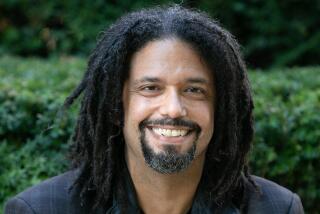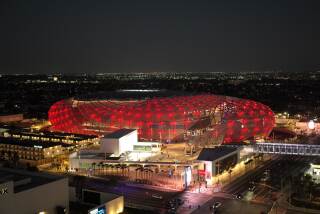For Arnie, a Time for Dedication : Now, Palmer Has Own Golf Course in Coachella Valley
- Share via
LA QUINTA, Calif. — It has been more than 30 years since Arnold Palmer first wandered into Palm Springs from a tournament he was playing in Brawley.
The impact he has had on golf in the Coachella Valley, stretching from the original nine-hole O’Donnell course in downtown Palm Springs to the new PGA West complex on the Indio city limits, is as significant as that of anyone--Ike, or Hope, or Sinatra, or the Agua Caliente Indians.
For years, there was a huge billboard along the highway into Palm Springs with Arnie’s face smiling out on all the golfers speeding to their tee times in the desert spa. There was no name on the sign. There was no need for one.
It was Arnie.
He won the Thunderbird Invitational before there was a Bob Hope Desert Classic and then he won his old pal Hope’s tournament five times.
The Hope, in fact, was the last PGA tournament Palmer won. It was 1973, the 61st tour event of his career. A 10th of his wins came in the desert.
Now Palmer has his own course here--The PGA West Arnold Palmer Course.
It is right across the street from where he, Jack Nicklaus, Lee Trevino and Fuzzy Zoeller will play the Skins Game next month at the PGA West Stadium Course.
“I remember, when I first drove over from Brawley to take a look at Palm Springs in 1955, that I said to myself, ‘What a great place for golf,’ ” he reminisced Tuesday after dedicating his course in a mini-Skins game with John Cook, Danny Edwards and Dave Stockton.
“I guess I wasn’t the only one who felt that way,” he added, grinning that infectious smile that has made him among America’s most recognizable athletes. “There were three courses in Coachella Valley then--Thunderbird, Tamarisk and O’Donnell. Now what are there, about 80 between Palm Springs and Indio.”
According to those who count, when the Palmer Course opened Oct. 17, it was officially No. 73, but there are at least seven or eight more under construction at this time--and many more on corporate planning boards.
“The environment in the desert has always inspired me to want to play my best,” Palmer told PGA West members. “I guess that accounts for all the success I’ve had here, right from the start.
“In ‘55, I wasn’t invited to the Thunderbird, so I played at Brawley in sort of a satellite tournament. I’d heard so much about Palm Springs and the movie people that I drove over to see for myself. I fell in love with the place.
“One reason I liked it so much was because it was so quiet. There weren’t many people here then.”
Palmer scored his first desert win in the 1959 Thunderbird Invitational at the Thunderbird Country Club.
“I remember it well,” he said. “I shot 62 the last day to beat Jimmy Demaret.”
That 62 is still his lowest score for 18 holes in a tournament, although he equaled it in the third round of the 1966 Los Angeles Open at Rancho.
Palmer didn’t shoot a 62 Tuesday, but he did make a spectacular birdie on the last hole, a 540-yard par 5 that wraps itself around one of the five lakes on the course.
Two of his younger playing partners, Stockton, 44, and Edwards, 35, laid up with their second shots. Cook, 29, came up short on his try to whip a wood shot across the lake.
Then came Arnie, 57, staring across the lake at the tiny green more than 260 yards away. He looked around at the small gathering, hitched up his pants the way he has been doing for 30 years, and pulled a wood from his bag.
“He’s going for it,” whispered the crowd to one another.
Whap! The ball soared through the desert air and landed just off the edge of the green, easily across. Arnie’s attempt at an eagle slid past the hole, but he sank a 15-footer to close out the day with a birdie.
Edwards was the big winner in the mini-skins game, thanks to chipping in the cup for an eagle on No. 11. He won $2,400, Stockton $2,000 and Palmer and Cook $600 each.
Inevitably, the talk came around to comparing Palmer’s course, 6,961 yards from the black tournament tees, 6,519 from the blue championship tees and 6,067 yards for the normal people, to the long and treacherous Stadium Course across the street.
The Stadium course runs from 7,271 yards to 6,313. Both are par 72, but there the similarity ends. Palmer’s course is rated at 73.4 when it’s stretched out. The Stadium course is 77.1.
Palmer refused to compare them.
“We didn’t build our course to compare it with the Stadium course,” he said. “We build ours for players of every caliber to play and enjoy.
“We built it for families. If one of them is a scratch player, he’ll find all he wants from the tournament tees, but if he’s an 18-handicap, or can’t break 100, there are plenty of ways around this golf course. And I guarantee you, all of them will have fun.”
Palmer’s course is backed up against the Santa Rosa Mountains and three of the final four holes criss cross the All American Canal.
“I have never played the Stadium course, but I know it is very difficult, and it was built to be that way,” Palmer said. “It is definitely more of a test, but there is a big difference between a ‘tough’ golf course and a ‘good’ golf course. I think we have a good one here. We are not looking for a comparison.
“Holes don’t have to be monsters to be great golf holes. I consider two little short holes, No. 16 and No. 17, to be fantastic holes. They are really great, and they are equally interesting to the best players in the world or the high handicap ladies.”
No. 16 is only 318 yards from the regular tees, but calls for two shots across the canal to a minuscule green. No. 17 is 104 yards from an elevated tee with the canal on the left and rocky outcroppings on the right.
Palmer designs and builds his courses in partnership with Ed Seay, former president of the American Society of Golf Course Architects. The Palmer Course Design Co. built the first course in China, the Chung Shan Hot Springs Golf Club in Quangdong Province, as well as courses in Thailand, New Zealand, Malaysia and Sardinia.
Some of the most noted golf course architects have their own trademarks. Pete Dye, who designed the Stadium Course as well as the Tournament Players Course in Ponte Vedra, Fla., makes liberal use of railroad ties. Robert Trent Jones’ courses are famous for their huge, undulating greens.
“When I am asked to design a course, there is one thing I insist on, that it does not have a trade mark linking it to Arnold Palmer and Ed Seay.
“First, we ask the client what kind of a golf course he wants, difficult, easy, long, short, tricky, wide-open and if he has a firm idea, we build him what he wants. If the client says, build it the way you want, we look at the available acreage and build a golf course in keeping with the surroundings.
“What I want to hear when someone plays my course is, after they finished their round, they say, ‘What a wonderful time I had, who built this golf course?’ ”
Despite all the work involved with building courses, running an automobile agency, an advertising agency and a rent-a-car franchise operation, Palmer is playing more golf than ever and enjoying it more, too.
This year, he has played in 14 Senior Tour events, in addition to several PGA tournaments such as his own Hertz Bay Hill tournament at the course he owns in Orlando, Fla. He made a check in all 14 senior tournaments, finishing second in the MONY Senior Tournament of Champions at La Costa and tied for third in the Senior Tournament Players Championship at the Canterbury course in Cleveland.
Last month, he eagled the final hole to beat Don January and win the Union Mutual Seniors tournament in Cape Elizabeth, Me., a non-tour event. It was his first win of any kind since June 1985.
“I played golf for most of my life out of necessity, to help pay the bills, but now I’m playing more for fun. Not as good, unfortunately, but I’m enjoying myself immensely.
“One thing that is fascinating to me is the new equipment coming out on the market every day. I’m experimenting with titanium shafts at the moment. This is a wonderful time to be playing golf, there are so many new ideas developing.”
One of the most enjoyable new ideas is the Senior Tour, which started sketchily less than a decade ago before it became Big Time when Palmer turned 50.
“There had been a call, even a need, for a second tour for some time, but now we have it,” he said. “The Senior Tour is the second tour. It has already reached maximum proportions.
“Next year, there will be 35 tour events with a purse of $11 million. It started as a spin-off from the regular tour, something to give some fun to some old fellows, but no more. Now it’s bigger than the PGA tour itself was 10 years ago.”
Eight years ago, to be exact. In 1978, the year Arnie almost won the Los Angeles Open when it was played at Rancho, there were 48 tournaments that paid $10,337,332.
That was the year that Palmer faded on the final Sunday, but not before most of the nation’s sporting media, in Los Angeles for the Super Bowl, dropped by to see if Arnie could win one more.
He didn’t make it, but it was such a Palmer crowd that when he faltered and slipped from contention, most of the huge gallery left the course before Dr. Gil Morgan came in the winner.
Arnie’s Army had no time for an optometrist.
Now that he has his own course, what’s left for Arnold Palmer in his beloved Coachella Valley.
“I want to play O’Donnell. I’ve never played it, and it’s part of the history out here.”
So is Arnold Palmer.
More to Read
Go beyond the scoreboard
Get the latest on L.A.'s teams in the daily Sports Report newsletter.
You may occasionally receive promotional content from the Los Angeles Times.










